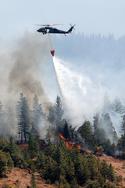A new report by the Center for Opportunity Urbanism, Beyond Gentrification: Towards More Equitable Growth, explores how unbalanced urban growth has exacerbated class divisions, particularly in the urban centers of our largest's metropolitan areas. To read or download the full report click here. read more »
Geography
The Bifurcated City
After drifting toward decrepitude since the 1970s, many core cities have experienced real, often bracing, turnarounds. Yet concern is growing that the revitalization of parts of these cities has unevenly benefited some residents at the expense of others. The crucial, and often ignored, question remains whether the policies that have helped spark urban revivals have improved conditions for the greatest number of residents. read more »
Low-Density Fire Buffer
Someone in Bend must be reading this blog, or at least thinking along the same lines. In 2017, after the Wine Country fires had burned homes in Santa Rose, the Antiplanner noted that the problem was the homes were too dense and needed a buffer of low-density homes around them. I made the same point after the Camp Fire burned homes in Paradise.
Now Deschutes County is zoning a buffer between Bend and the national forest for low-density housing. read more »
- Login to post comments
The Tech Economy’s Untold Story
The decisions by Amazon and Google to expand into the New York area have led some pundits to claim that the nation’s high-tech economic future will be shaped in dense urban areas. read more »
- Login to post comments
Pittsburgh & Rochester: Best 2018 International Housing Affordability
Pittsburgh and Rochester have the best housing affordability among 91 major markets (metropolitan areas with more than 1,000,000 population) in eight nations. Both have a median house price that is 2.6 times the median household income, a measure called the Median Multiple. This is the conclusion of the 15th Annual Demographia International Housing Affordability Survey, which rates housing markets based on estimates from the 3rd quarter of 2018. read more »
- Login to post comments
The Labor Market Is Changing: Is Your Company Ready?
Ever since the economy began to bounce back, with unemployment at an all-time low, the familiar refrain from pundits has been that growth, particularly of the higher wage variety, would head to the tech-oriented elite cities along the coasts. Yet, today, despite the headlines about Amazon’s expansions in New York and Washington, D.C., the real story is the aggressive growth taking place on a changing stage, both in terms of geography and changing labor demands. read more »
- Login to post comments
The Democrats Finally Won the Suburbs. Now Will They Destroy Them?
The Democratic Party’s triumphal romp through suburbia was the big story of the midterms.
In 2016 the suburbs, home to the majority of American voters, voted 50 to 45 for Donald Trump; this year, 52 percent went Democratic. read more »
Amazon, Google, Apple and the Late Capitalism Blues
We think of the movements of high-tech firms as illustrative of totally new phenomena but it resonates as well with earlier industrial history. The “gilded age” of America, when industries expanded rapidly, produced a growing appetite for labor. Automation in production also expanded output and revenue, but also a growing need for workers. read more »
- Login to post comments
Can High-Speed Rail Make Housing Affordable?
UCLA management professor Jerry Nickerson thinks he has found a solution to California’s housing affordability problems: high-speed rail. Based on years of data, he has concluded that some Japanese who work in Tokyo and other expensive cities make long commutes on high-speed trains to more affordable cities elsewhere in the country. read more »
- Login to post comments
Suburbs and Exurbs Dominate Mid-Decade Millennial Growth
America’s suburbs and exurbs continue to dominate population growth among post-college Millennials, those aged 25 to 34 in the 53 major metropolitan areas. This is indicated by data in the just released 2013/2017 American Community Survey (ACS), which provides a mid-decade snapshot of US demography. With its middle sample year of 2015, the 2013/2017 ACS is most representative of the middle of the decade between the 2010 and 2020 censuses (Note 1). read more »





















